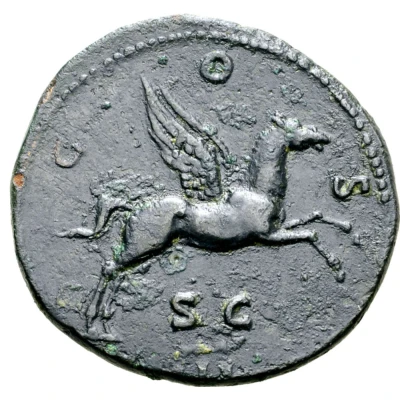Dupondius - Hadrian COS III III occasionally in exergue S C; Pegasus
| Orichalcum | 12.5 g | 27 mm |
| Issuer | Rome › Roman Empire (27 BC - 395 AD) |
|---|---|
| Emperor | Hadrian (Publius Aelius Hadrianus) (117-138) |
| Type | Standard circulation coin |
| Years | 124-125 |
| Value | 1 Dupondius = ⅛ Denarius |
| Currency | Denarius, Reform of Augustus (27 BC – AD 215) |
| Composition | Orichalcum |
| Weight | 12.5 g |
| Diameter | 27 mm |
| Shape | Round (irregular) |
| Technique | Hammered |
| Demonetized | Yes |
| Updated | 2024-10-06 |
| Numista | N#255283 |
|---|---|
| Rarity index | 97% |
Reverse
Pegasus, left.
Script: Latin
Lettering:
COS III (III occasionally in exergue)
S C
Translation:
Consul Tertium. Senatus Consultum.
Consul for the third time. Decree of the senate.
Comment
Source: Online Coins of the Roman Empire (OCRE)Interesting fact
The Dupondius coin featuring Emperor Hadrian and a Pegasus on the reverse was minted during a time of significant economic and military expansion for the Roman Empire. The coin's design, which includes the image of a winged horse, symbolizes the empire's growing power and influence. The use of Orichalcum, a copper-zinc alloy, in the coin's production also speaks to the empire's advanced metallurgical techniques and resources. Overall, this coin serves as a tangible representation of the Roman Empire's strength and prosperity during the 2nd century AD.

